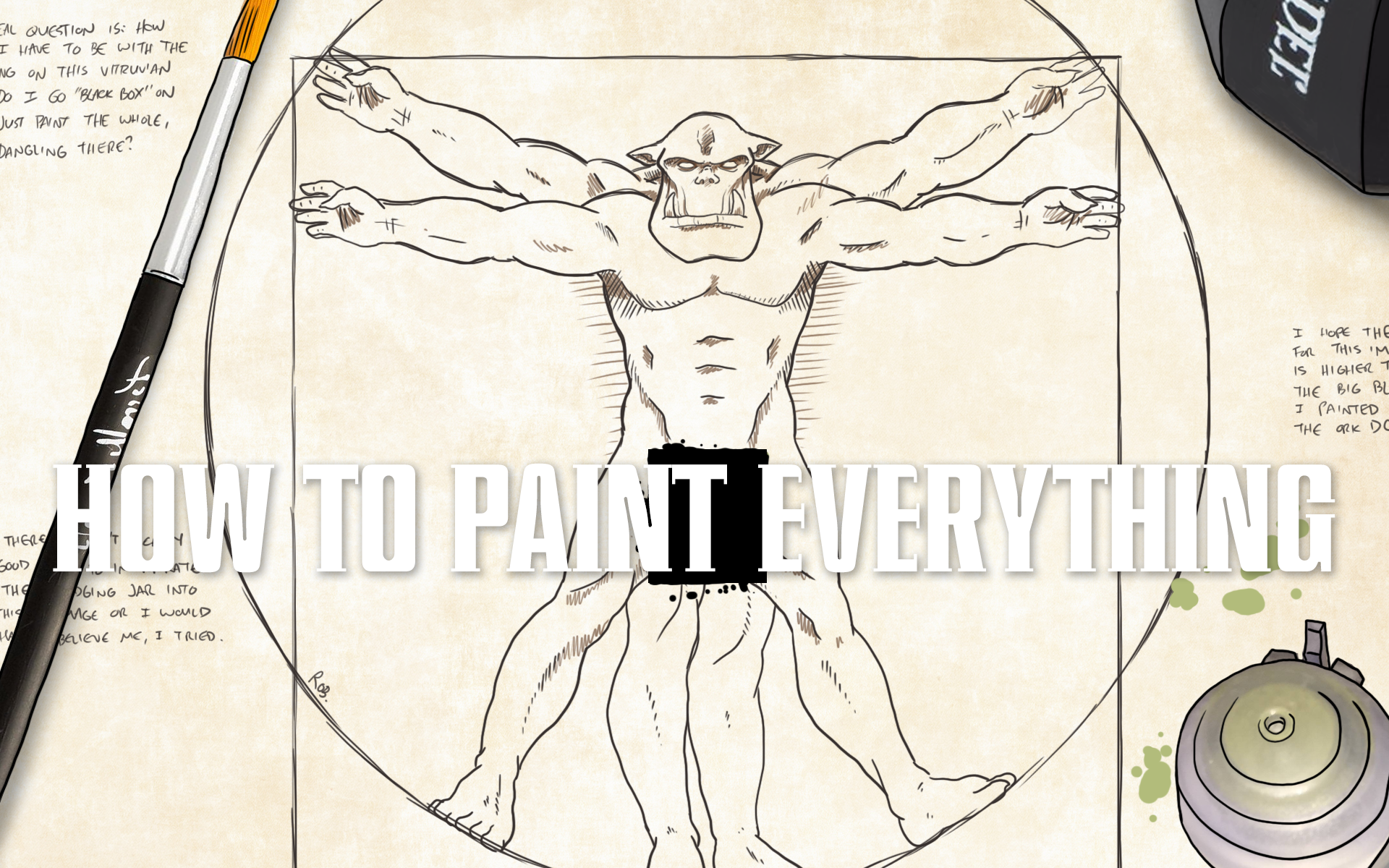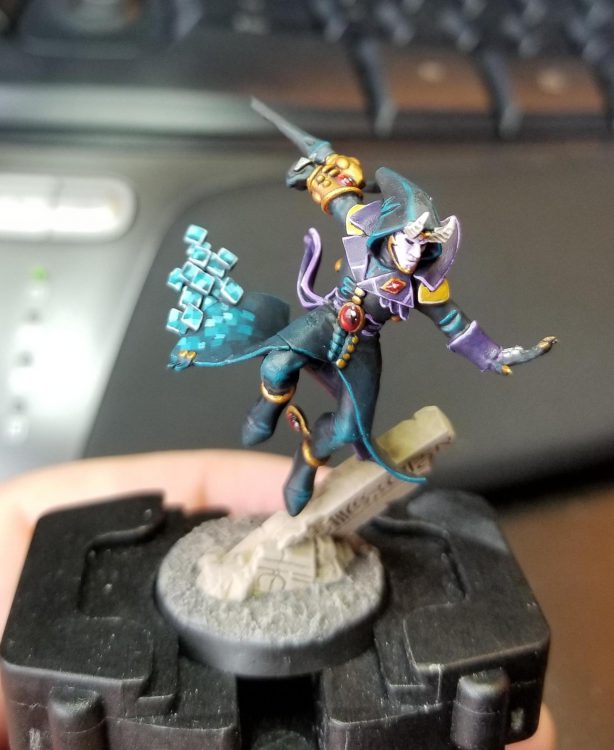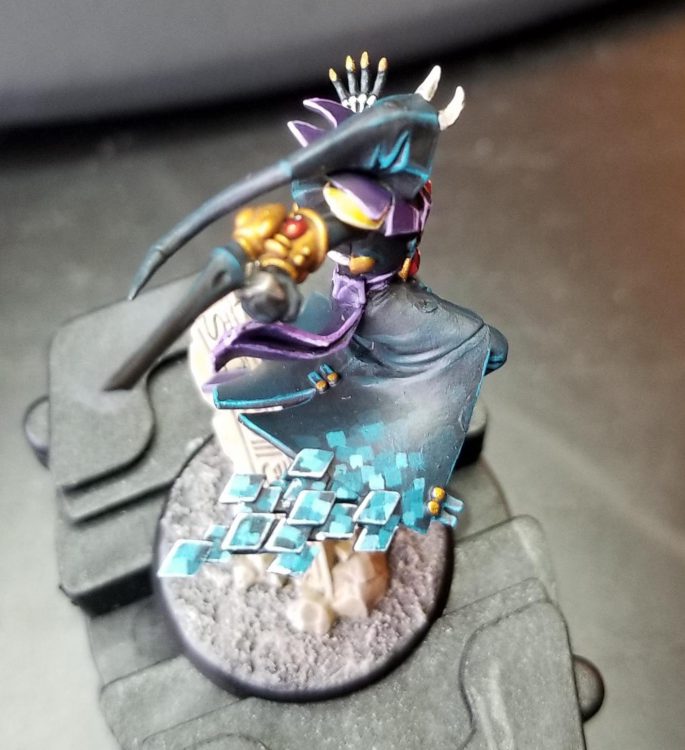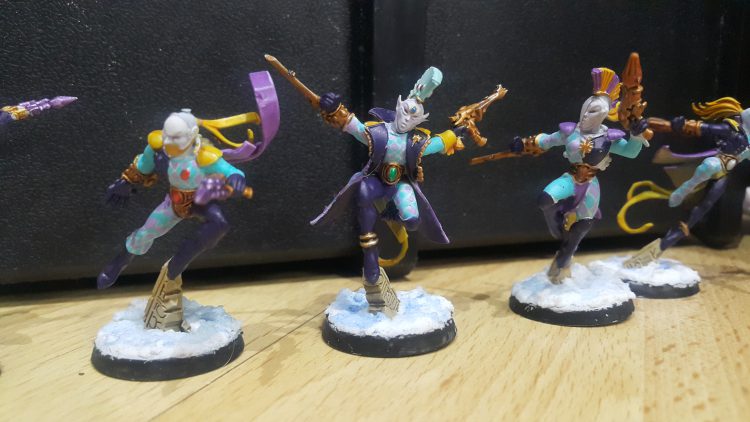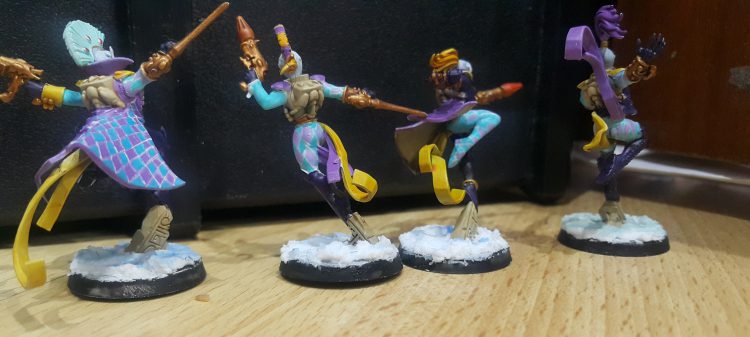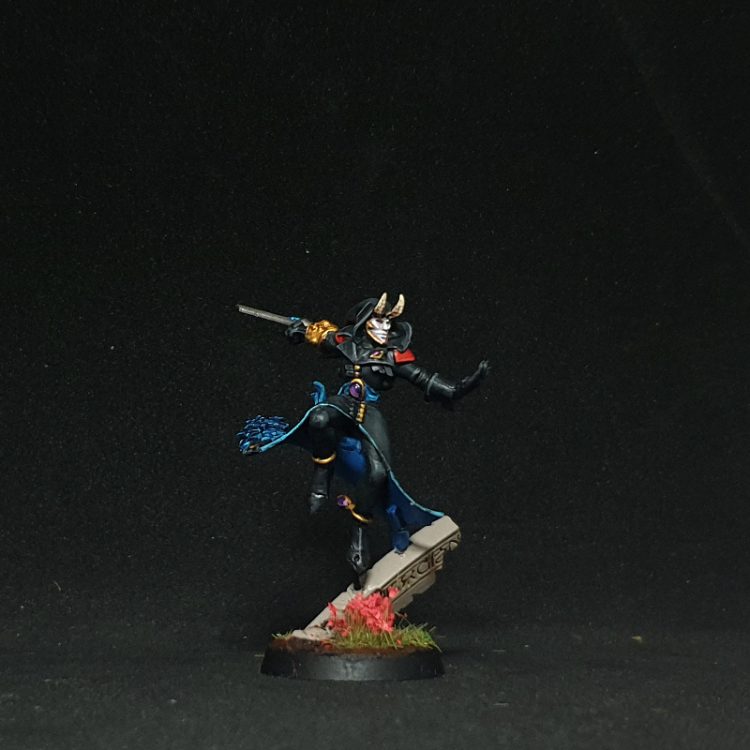In our How to Paint Everything series, we take a look at different armies of the Warhammer universe, examine their history and heraldry, and look at several different methods for painting them. With the release of the new Psychic Awakening rules for Harlequins, there’s a lot of excitement about the game’s enigmatic murder clowns. So today we’re digging into how to paint them and all of the colorful shapes and patterns that cover their clothing and vehicles.
Who Are the Harlequins?
Among the ancient Aeldari race the Harlequins are a unique and enigmatic group, owing their allegiance to Cegorach, the laughing god, and no one else. This group of highly-skilled warrior-dancer-actors work with the aspect warriors and farseers of craftworlds, the kabals of the Drukhari, Exodites, and Corsairs, helping shape the destiny of the Eldar race. They also frequently meddle in the affairs of other races, and have been known to work with Inquisitors, traitor marines, and even Sisters of Battle from time to time, always in the interest of furthering the Laughing God’s plans in the long war against Slaanesh.
In the time before the birth of Slaanesh, Harlequins served as a kind of roving street performers, but in a very performance-art way that served to needle the then-hedonistic Eldar about how completely shitty they’d become as a species. This did not go over well, and the Harlequins ended up also learning to be expert fighters so they could escape from their own trolling performances with all their limbs intact. When the race fell and caused the birth of Slaanesh, the Laughing god escaped and spirited the Harlequins into the Webway, where they went on to prepare for an eternal war with the newly birthed Chaos god. They also probably yelled a few “I told you sos” on their way out too.
The Harlequins aren’t really a race among the Eldar but are more like a “shadowy cabal that lures in new members via what looks like sorcery to most, including the Eldar.” New recruits leave their identities behind and don masks, joining theatrical groups of warrior-performers called troupes led by avatars. Get a few of these together and they form a Masque. In Eldar society, the Harlequins are known for performing a dance that re-enacts the fall and the great war the Eldar must fight against Slaanesh. This is called “The Dance Without End” and requires a Solitaire, who are the only Harlequins allowed to play the role of She Who Thirsts and as a result are considered weird and kept distant even from other Harlequins.
The Harlequins are one of the few groups in the galaxy who know the way to the fabled Aeldari Black Library, a collection of all of the race’s knowledge of Chaos, and Solitaires among the few who are allowed to enter the Library as they please.
Where to Read More
Harlequins show up all over the place in 40k fiction, usually directing the actions of protagonists in other factions rather than acting as protagonists themselves. If you’d like to read more, check out the following:
- Path of the Eldar involves Harlequins at several points, though they don’t play a huge role.
- The Masque of Vyle is a novella that focuses more heavily on them, albeit in short fashion.
- Harlequins play a major role in Josh Reynolds’ Fabius Bile series, which currently includes the books Clonelord and Primogenitor.
Visual Inspiration
Harlequins first appeared in 17th century English literature, but likely date back to Italian works from the Commedia dell’Arte, a form of professional theatre, in the late 16th century. They’re primarily categorized by their colorful costumes, often featuring diamond patterns. They’re often associated with clowns, but as opposed to clowns’ more oafish antics, harlequins tend to be more romantic characters, and more graceful. Visually, they’re often marked by diamond patterns.

In the 40k universe, Harlequins have been known for visually replicating this diamond pattern on a variety of cloaks and vehicles, but they also generally just make use of more bright colors and patterns. Depending on how you want to represent your masque, don’t be afraid to get away from this a bit – spirals and star fields can also work very well here. Older schemes from the ‘Eavy Metal team also used stripes and triangles.
Playing Harlequins
Warhammer 40,000
We’ve written up a full guide to playing with Harlequins, which you can find here in Start Competing: Harlequins. If you just want to read about their rules update in Psychic Awakening however, you can find that here.
Kill Team
We’ve also written a guide to playing Harlequins in Kill Team! You can find that here.
Painting Harlequins
Harlequins can be daunting, especially for newer players. While the models themselves aren’t super complicated, the paint jobs you see on them often use a lot of patterns and freehand, which can be difficult for newer players. In this section, we’ll explore some common patterns and techniques
Robert “TheChirurgeon” Jones
I don’t play Harlequins but I’m a big fan of the models. When I started the Astradus Campaign early last year, I wanted to have ally models the players could pick up and add to their armies during the campaign and I knew that a Solitaire would be a great addition to that group, since they’re known for “helping” characters from various factions in order to achieve their strange goals. After painting this model, I liked it so much I didn’t want to give it away!
I didn’t stray too far from the studio design, but I knew I wanted more of a bluish hue to the cloak than a flat black with gray highlights.
Primer: Black. Always black. I use GW primers because I like their consistency. For the Solitaire, there aren’t a lot of hidden spots on the model so I assemble in full before priming.
Basecoating: I basecoated the main cloak with Incubi Darkness, then set to darkening the cloak using a mix of Incubi Darkness and Abaddon Black, so I could work up to Incubi at the higher points and have something that was darker across most of the cloak. I wanted the cuffs and collar to be purple so I basecoated them with Naggaroth Night and worked that up with some Xereus Purple. The facemask was a bit of Reaper Pure White mixed with a tiny bit of Xereus Purple, and the stone base was basecoated with Karak Stone. Once I had the fades on the cloak, I edge higlighted it with Incubi Darkness and a bit of Sotek Green.
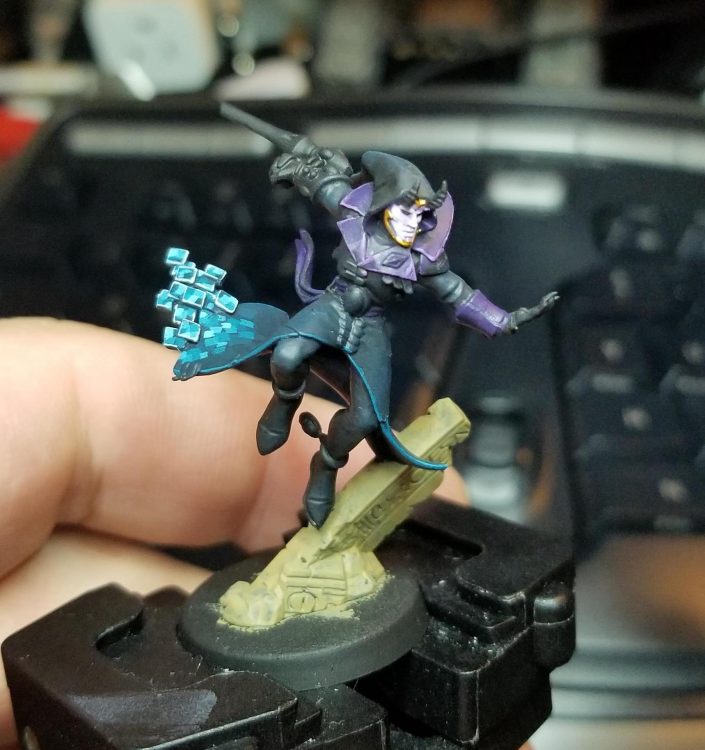
Time for the Harlequin digital rez patterns!
These I did freehand, starting with squares/diamonds of Incubi Darkness, then Sotek Green, and then a few shades of Sotek Green mixed with white. I did 5 shades total, then edge highlighted the diamonds coming off the cloak with Reaper Ghost White, which is a very light blue/off-white shade.
The goal here is to do a layered approach, where you start with the dark shapes in the background and then paint newer diamond shapes over those in various places. As you paint lighter squares, have them overlap the darker ones, and work outward, so that you have more dark patterns/squares that match the cloak’s color more closely as you go towards the model, and have lighter colors on the diamonds as you move away from the model.
Time for some details!
The Mask I washed with Duruchii Violet and then painted with white mixed with a touch of purple to get an even lighter shade. I did a similar fade on the horns coming away from the mask and painted the edges in Retributor Armour Gold washed with Agrax Earthshade.
The Lapels, sash, and cuffs I highlighted with a mix of Xereus Purple and white, edging with a lighter shade. I also continued to do some highlight on the Cloak and Leggings with Sotek Green.
The Shoulderpads were painted Averland Sunset, then highlighted with a mix of Averland Sunset and Flash Gitz Yellow, then edge highlighted with a mix of Averland and Pure White.
The Gold is just Retributor Armour Gold washed with Agrax Earthshade and edged with Runefang Steel/Ironbreaker.
The Gemstones were done with a base of Mephiston Red, then shaded with Khorne Red, Carroburg Crimson, Nuln Oil, and Abaddon Black doing a gemstone fade to the upper right, then I put a dot of pure white over the black. I added a swoosh of Evil Sunz Scarlet and Jokaero Orange on the lower left, then coated the finished gemstone with ‘Ardcoat.
Finally I put some Astrogranite technical paint on the base and drubrushed the whole thing with Reaper Polished Bone to give it a dry, stone look.
I did a little more blending on the knees to tighten that up and called it a day. I’m pretty happy with how this came out, though if I had to paint another one I’d put more work into filling that gap in the cloak over the knee. At the time I was planning to give the model away as part of the campaign and wasn’t real interested in putting in the time to do stuff like that, but now that I’ve kept the model I regret my hasty decision.
Anders Gojardo Westrum-Rein
Despite being Norwegian and sporting a beard, I’ve always been more fascinated by elves than viking muscle wizards and barbarians. Having originally started out with High Elves and Tomb Kings in fantasy battles around 2005, I got back into the hobby, and got introduced to 40k for the first time a month before the release of 8th edition. After the initial Space Marine purchases, I saw the Harlequin models in the store and bought a troupe and a few bikes, and while I love the “yeah these rules don’t apply to us” rules Harlequins have, I think you appreciate them more if it’s not your first army.
I’ve never considered myself a good painter, so there’s several reasons why I decided to go with the Nebula scheme for my Harlequins:
- I don’t have to paint a single diamond.
- I’d never tried the dabbing technique before, and it gave me a new perspective on how lighter and darker colours interact, which helps me as I’ve just gotten started on wetblending colours. T
- They paint up relatively quickly, and flicking paint at models (with my desk, computer and dog in the crossfire) feels both right and wrong at the same time

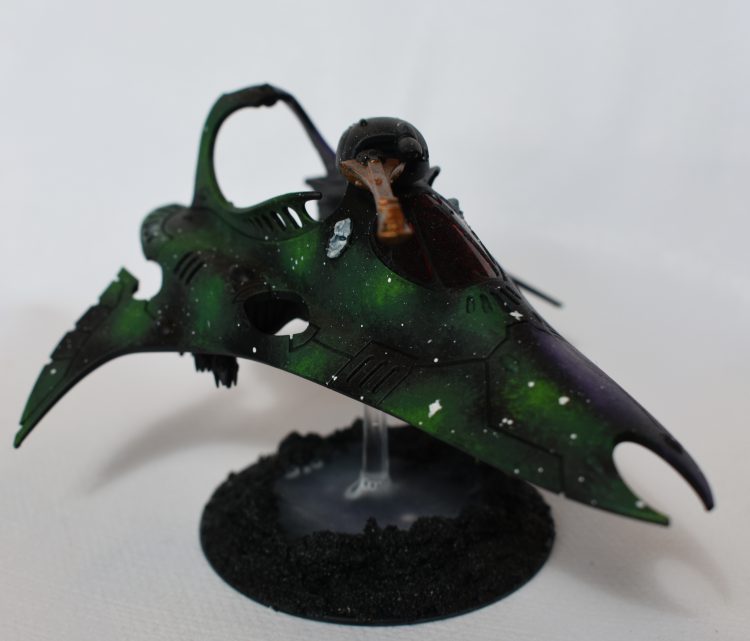
Prime/Undercoat: Black
The Nebulas: The nebulas are done by undercoating black and then dabbing lighter and lighter colours on top of it. For instance for green, you could start out with Vulcan green or Waagh! Flesh, continued by Warboss Green and then Moot Green in smaller and smaller areas. I don’t really thin my paints when I do this, I just wipe excess paint off the brush just like when I’m drybrushing. Dab the brush against the model – you’re giving your plastic toys a rough massage with your brush. It will fuck your brush up.
The Stars: For the stars, I use Vallejo White Grey. It’s an airbrush paint, but you can also do a 50/50ish mix of white paint and water, as you want the paint to be thin. Add the paint to a brush with stiff bristles, point your brush towards the model, pretend to be Dennis the Menace and pull the bristles back, flicking white paint over the area.
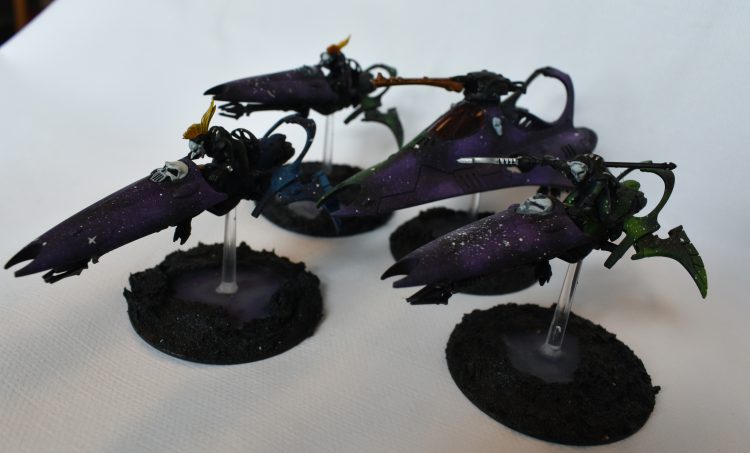

Chucat’s Method (with Diamonds)
I played Eldar since 3rd Edition (ignoring the part where I then stopped playing for the next 4 editions) and when I came back and got into painting my Eldar again, people who I knew kept saying “Chu, you should paint Harlequins, because you use really ostentatious colour schemes and use edge colours as basecoats, and also because we know you hate yourself and want to die” It then turns out I also wanted some melee in my army that wasn’t ‘trashcan garbage’ so I added a squad of Harlies, a clownbus, and a Troupe Master to my army, I blew up a couple of Knights with them. Then GW proceeded to remove the interaction between Harlequins and Craftworlds, so uh… cool, the real experience was the diamonds I painted along the way.
I wanted my Harlies to match the rest of my Eldar army, which meant I’d be going for lliac and turquoise as my main two colours, to seperate them from the rest of my Eldar, I’d use a dark purple as my third colour (because I like dark purple), and then yellow as the other spot colour (because I hate myself).
Warning, I am a scumbag who paints stuff in really simple ways, I don’t even know what an edge highlight is 99% of the time. A lot of my method comes from Games Workshop’s tutorial
Primer: I used Corax White, because I always use Corax White, because I paint everything to look really bright. I assembled everything together because I didn’t want to subassemble these and the kits gave me a surprising amount of room to work with.
Dark (for me) Purple (Cloaks and Streamers): I used Genestealer Purple as a base colour, then drybrushed or picked out highlights using Dechala Lliac. If I was doing these again, I’d use Kakaphonii Purple as my highlight colour, since it didn’t exist back then.
Yellow: I used the “cheapass scumbag method” that GW came up with. You just shade the white with Cassandora Yellow, and then you use Lamenters Yellow on top of that. That’s literally it. If you got another colour on the areas you wanted to paint yellow, then I assume you just damn yourself for all eternity or something.
“Black”: This was just Naggaroth Night, cool, glad we got that sorted out.
Diamonds(!!!!!!): Right, so this is the most important part of this, and why you’re probably actually reading this, so I’ll go into a bit more detail.
- Step 0: Remain calm, you’re trying something new and really, really hard. No sane person is going to care if you mess this up, they’re gonna think you’re a badass for even attempting it, trust me.
- Step 1: Cover the area you’re going to diamond up in your base colour, in this case, it was Baharroth Blue, make sure it’s nice and smooth, or don’t, I’m not your mother.
- Step 2: Get the smallest brush you have (so for me this was an artificer brush), and then start drawing diagonal lines over the area you intend to diamond up, I used White Scar because I like my stuff to be bright, but you can use Abaddon Black if you want (reference the earlier point where I am not your mother), if it’s around a leg, you’re gonna be doing a spiral essentially.
- Step 3: Once you’ve done all the diagonal lines one way, start doing them the other way, and then you’ll have this slightly cruddy looking cross hatch over your model’s leg or chest or something.
- Step 4: Contemplate if you’re still in control of your life. Don’t worry, you are.
- Step 5: You’re going to begin blocking in those diamonds now, for this, I used Dechala Lliac and Baharroth Blue. Keep the following things in mind:
- Diamonds will share a colour if they touch on their corners. If you’re doing some sort of triple colour scheme (trimonds?) then uhhh…work out what you’re doing beforehand.
- I didn’t have to/want to water down my paint much for this, but that might be because Edge colours are weird, you don’t want it to flow too much (otherwise you’ll be there for 10 hours), but then you don’t want it to horribly goop up either.
- Don’t worry if you make a mistake! Just go over it with the correct colour.
- Step 6: You can shade and highlight the diamonds if you want. I didn’t, but there is nothing stopping you, you’ll just need to be more precise.
- Step 7: Enjoy your diamonds, if anyone gives you shit over them not being perfect, force feed them their own models.
Masks: You’re gonna want a small brush here once again. All you have to do is just apply a bit of Druchii Violet to the recessed parts of the mask, it makes everything pop and looks really nice.
Gold/Bronze: I used Liberator Gold and then used Agrax Earthshade on top of it, then highlighted with Liberator Gold and Runefang Steel.
The Ruins the Harlequins are Jumping from: I literally just used Seraphim Sepia, yeah, the wash. Pretty cool, huh?
Gems: Runefang Steel and then Technical Gem Paints, easy peasy.
James “Boon” Kelling
I’ve been an Eldar player for over 22 years now and while they’ve always been my main squeeze, I’ve always had a periodic soft spot for the clowns- especially in the lore (since that’s where they mostly resided since 2nd ed). I think we can all agree, even if you hate elves aelves, that Harlequins are pretty damn cool. I missed them in 7th since I took a break from the game towards the latter end (what a bad edition) but when I came back in 8th I picked up some of these awesome models to paint for fun. Then the codex released and they’ve been a periodic addition to my lists ever since.
I’ve always like the look of purple/pink combined with teal but never really had a platform for it since I sold my Tomb Kings way back – didn’t even think of Soaring Spite as I planned my scheme – but it was a nice coincidence.
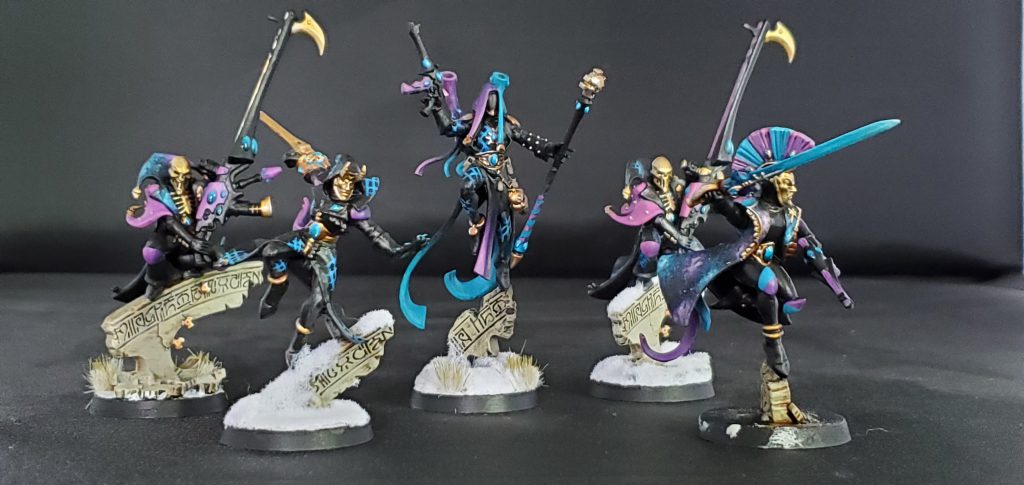
I should preface all this by stating that I’m actually going to be revamping the models slightly and touching up the look of the nebulae to be less spotty and the gems to be deeper looking.
Color Palette:
- Black: Abaddon Black
- White: White Scar
- Purple: Naggaroth Night, Xereus Purple, Genestealer Purple, Emperor’s Children
- Teal: Thousdand Sons Blue, Ahrimen Blue, Temple Guard Blue, Baharroth Blue
- Gold: Balthasar Gold, Auric Armor Gold, Stormhost Silver
- Brown/Leather/Ruins: Gorthor Brown, XV-88, Ushabti Bone, Seraphim Sepia
Primer: Black, obviously. I use Rustoleum Black Paint + Primer – no particular reason but it covers well and isn’t thick.
Basecoating: I ALWAYS start every model with black. I prefer the base of all my models to have a darker finish and underarmor as it gives a good contrast to what I want to do to the raised armor elements (blend from left to right, light to dark). With Harlequins I was actually a bi challenged since black doesn’t work for this all that well as a main color – so I’m not 100% in love with the results but I try to cover for this with the nebulae look.
Purple/Teal: Next I lay down where I want the purple and teal to be and overlay the layers from dark to bright. Then I blend where i want the ‘light’ to cut away
Gold: Next step is to lay out the gold trim, starting with Balthasar on all the gold bits, then on the bright side Auric Armor, and highlight with Stormhost and then go back and blend some of the Stormhost into Auric. Auric Armor gold is, frankly, an awful covering paint, but going back over Stormhost is works just fine.
Gems: I used to base the gems with the darkest color in the color – so in this case my gems are teal and I used Thousand Sons Blue – I’ve since changed how I do my gems and it starts with black, with half of the gem remaining black but the rest blended up to the brightest color in the range (in this case Baharroth Blue). Then I place a dot in the black away from the light. Later after the varnish I’ll go back and cover with an ‘Ardcoat.
Nebulae: Originally I used a cross-hatch pattern (can still be seen on the Troupe below) but have been updating to a nebulae pattern. It starts by taking white and ‘flecking’ on the black by loading up a wider brush with paint and lightly running my finger across it to throw paint spot onto the model. It results in a random pattern of small and big dots. Afterwards I’ll follow a similar process as Anders except I’ll add a white ‘star’ by putting a small white + sign with a slightly elongated north/south line. After that I’ll mix white with my lightest nebulae color, water it down, and lightly apply it over the top to slightly obscure the star formation and give it a very bright halo.
After that I’ll touch up the colors, varnish satin for a stronger protection, and then varnish in matte to cut the glare. Then I’ll ‘Ardcoat the gems. Voila!
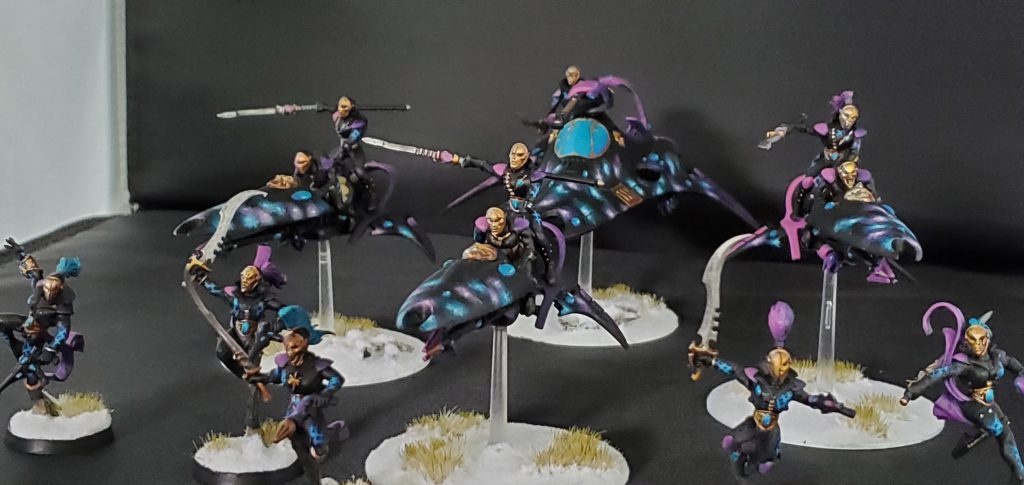
Liam “Corrode” Royle
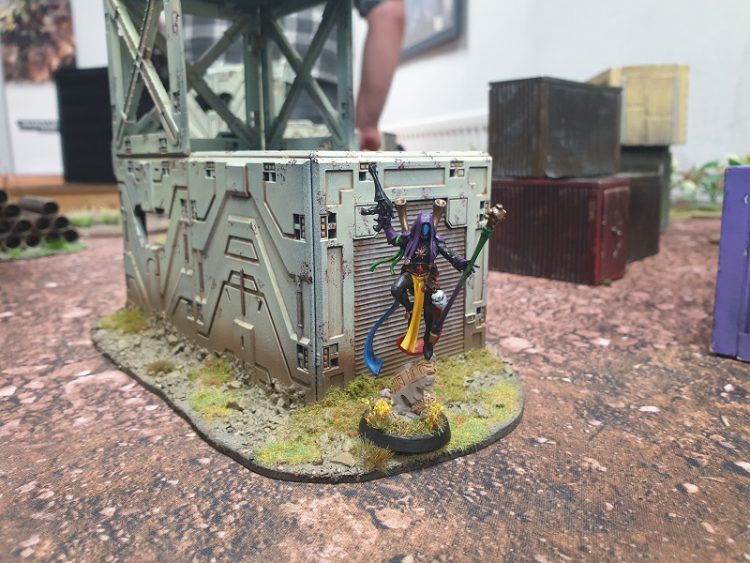
My main goal with Harlequins was not to paint any diamonds.
I’m rubbish at freehand and I don’t have an airbrush, so either of the common ways of painting diamonds on things was right out. Instead I went the other way, with largely black bodysuits and guns, and then touches of colour to bring out different details and play into a similar aesthetic without having to resort to hours of painting tiny regular quadrilaterals on curved surfaces. One way of approaching this was the Shadowseer you can see above – the bodysuit is black, and then I painted each of the three bits of cloth a different primary colour. The other details are then painted in the mixes of those colours – purple for the hat and gloves, green for the tassel on the arm, a purple-green blend on the stave, and then the metals done in Runelord Brass, which to me at least looks quite orange. It’s just about coming at the thing from a different angle.
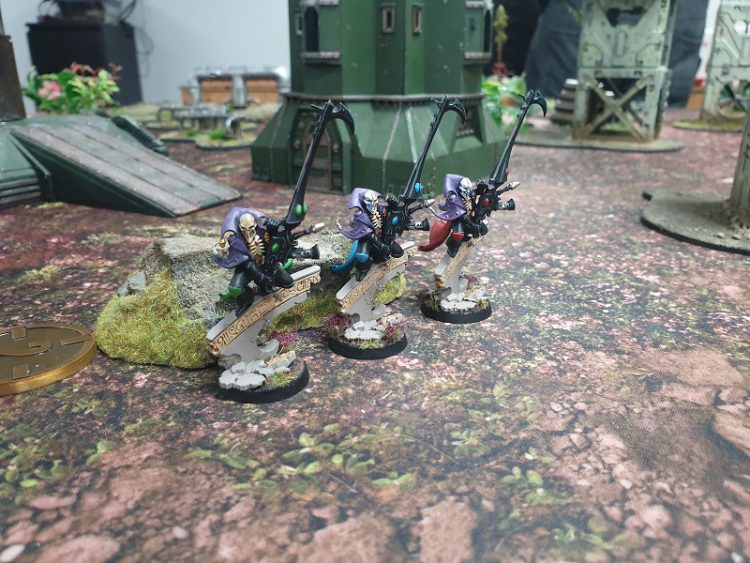
The Death Jesters had a similar approach. This time I painted their bodysuits, skeletons, and guns the same way, and gave them all the same purple jacket, and then picked out details – the gems on the guns, the kneepad, and the cloaks – in different colours. They’re all tied together visually by the purple (which also ties them to the Shadowseer) and then they each have their own colour, which besides anything else is extremely helpful for picking out which is which on the tabletop – the green guy is my favourite and usually is the one carrying Curtainfall, for example.
Finally the Solitaire, the first model I painted for the Harlies. Like the others he has a lot of blakc, but the inner lining of his coat is blue, which matches the webway shards or whatever the hell those things are on the edge of his coat. The Harlequin masks I’ve generally washed in Drakenhof before relayering them in white, which makes them quite cold, but with this guy I did it with Druchii Violet instead which lends it a slightly different tone.
For the rest of my Harlies, I’m planning to do them in a few different schemes. The fusion pistol guys will probably be similar to the ones above, with different colour combos to distinguish squads – I’m currently thinking one will be blue/green and another will be pink/yellow, while the big murder blob will be primarily red. I’m normally someone who aims for uniformity in an army to tie them all together, but I think Harlequins are a good time to let that loose a bit and paint a variety of different schemes. What will tie them together is the flowers on the bases – annoyingly the Solitaire picture here uses the red ones, but I’ve replaced those with yellow like the Shadowseer has. The Death Jesters totally have purple by deliberate choice because they’re cool and deathy and not because I forgot about this plan while painting them.
Additional Resources
Hopefully we’ve given you some real inspiration and things to consider but if you’re interested in more, there are a few other sources on Goonhammer we’d recommend:
- How to Paint Everything; Checks, Hazard Stripes, and Other Heraldry covers how to paint a lot of common designs like checkered patterns that will show up on Harlequins.
- How to Paint Everything: Freehand goes into detail on how to design and execute a good freehand design, something that will also be common on Harlequin vehicles.
And as always, if you have any questions or feedback, drop us a note in the Comments below or email us at contact@goonhammer.com.
